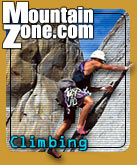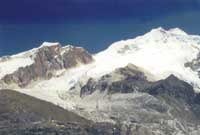
|
First Time Ascents into Bolivian Splendor July 21, 2003 Pages »1 2
Five hundred vertical feet till the summit and I feel like I'm running uphill with a snorkel clenched between my teeth. Every 15 to 20 steps I stop to take deep, though unsatisfying gulps of rarified air. In through the nose, out through the mouth, just like Fernando, my guide, taught me during my first climb. But that was thousands of feet ago, in the foothills of a kinder, gentler mountain. On this snow-covered, steep pitch of Pico Milluni -- made blindingly white by a powerful mid-afternoon sun -- his technique isn't doing the trick. Sweat pours down my back though it is well below freezing. One slogging footstep after another now, ice axe in hand, my steel crampons scrape feebly over polished snow, searching for a secure foothold that will get me one step closer to my goal. I muster the energy to look up at the sky, a Herculean effort in my condition. It is a richer shade of blue than I ever thought possible this side of outer space. Mustn't get distracted though. A slip could send me and my roped-in guide down a very precarious slope and over a ledge toward an unseen abyss. What I wouldn't do for a sea-level gulp of oxygen-saturated air about now. Summit's only 300 vertical feet away. Must focus. I had traveled to Bolivia to report on the political scene and economic plight of South America's poorest nation, a land-locked country dogged by corruption and revolutions (over 100 of them since its independence in 1825). The more immediate reason is Bolivia's latest bout of turbulence, the February riots in La Paz that left more than two dozen people dead and shook many Bolivians' belief in the ability of President Gonzalo Sanchez de Lozada to lead them out of its latest economic slump. I also came here hoping to learn the ropes of big mountain climbing since Bolivia has a handful of world-class mountains, some of which are visible from downtown La Paz and satisfy the experienced mountaineer's zeal for climbs over 20,000 feet. But I was a novice in search of some professional guidance before setting my sights on a biggie. Mountaineering is a sport like no other and not to be taken lightly. A superb athlete of marathon caliber fitness might not make it past 15,000 vertical feet due to the discomfort -- and possible death -- brought on by cerebral edema.
In fact, sometimes the ultra-fit are at a disadvantage -- their hubris leads them to believe they can race up the mountain, only to be turned back by an excruciating headache that has you praying for death just so the throbbing subsides. With that in mind I decided I wasn't taking any chances. When I arrived in the world's highest capital, I had a rudimentary understanding of just what altitude can do to you. At nearly 12,000 feet, I immediately felt La Paz's ill effects. Dog-tired, I couldn't sleep. Starving, I couldn't eat. Headaches made even walking in downtown La Paz hard to work the first couple of days. Reading nauseated me, and frequent naps were my only relief from mild dizziness. But after three days, I was getting my altitude legs. One week after my arrival, I was planning my first excursion into the Andean peaks. A friend in town mentioned a couple of summits I could cut my teeth on to see if I had what it took to get to the next level. I signed on with a tour company that had a reputation for being the best in town, and thereby one of the most expensive. But in terms of mountaineering costs, Bolivia is a bargain. What will cost a climber several thousand dollars in guide services in, say Nepal, will only put you out a few hundred in La Paz. On the day of my initiation to mountaineering my guide drove us an hour and a half from my downtown hotel north toward the Zongo Valley. Minutes from camp, I scored my first llama sighting, a prerequisite for any trip to the Andes. The serene grass-munching tableau soon turned into another first: my first llamas-humping-wildly scene. Shaking off the image of dirty wool ardor, I focused my attention on the valley's most famous resident as it came into site, the peak of Huyana Potosi. At 19,974 feet the mountain satisfies the urge of most intermediate climbers. Above which is sometimes known as the "Death Zone" because the thin air can inhibit a climber's ability to maneuver and focus, increasing the chances for a fatal mistake. But Summit Huyana wasn't on my menu. Not this time anyway. I was just hoping to bag a couple of its smaller siblings. I'm a greenhorn climber, a rookie mind you. The only mountain on my resume was a 14,000-foot, hike-up peak in Colorado, nothing approaching the heights I'd attempt here. Even the boulder and grass-strewn base camp at Zongo exceeded the highest altitude I'd ever reached. At 15,420 feet the air was thin, but, with deep breaths, tolerably so. My first attempt at real mountaineering would be the 17,690-foot summit of Charquini, a relatively easy climb by Bolivian standards. During the two-hour approach hike of little grade, my guide Fernando filled me in on what to expect once we approached the mountain's glacier and began the technical part of the climb. Now I'd seen glaciers from planes and learned about them in sixth-grade earth science, but no number of aerial views or sleep-inducing slide shows prepared me for the spectacle I was about to see and touch.
They are also incredibly beautiful. Their varying shades and contours give them a lifelike quality, like an enormous white mammal lying dormant on the mountainside. On them you must tread lightly for fear of waking the beast. At the base of Charquini's glacier, Fernando showed me how to secure the metal spiked crampons to my plastic mountaineering boots and gave me a lesson on ice axe use. The trick to steep glacier climbing is to maintain a rhythm: Thrust the pointed, handle-side of the axe into the glacier, follow with two, short escalating steps up the glacier -- all this at an angle up the mountain, of course. Glacial climbs of 45-60 degrees require that you zigzag your way up the icy face. Anything steeper and you can use a vertical ladder-like approach with your axe leading the way and the crampons' toes digging into the face. Each technique leaves you susceptible to slips and falls if you don't know what you're doing, which I was becoming increasingly aware of during my first few stumbles and slips. But after some coaching and a few adjustments to my style, I was finally getting the hang of it. We spent the next hour and a half switchbacking up the glacier, pacing our climb to the mountain cone and onto a small peak barely capable of accommodating the two of us. My lesson in patience and technique paid off when we reached Charquini's summit, a view more spectacular than I'd ever imagined possible. The sun glimmered off white-frosted peaks in front of us. Behind was a valley of seemingly endless expanse. The moment was intoxicating. I want more peaks, I thought, craving higher mountains and mentally planning my next conquest.
Page 2 »
|
||||||||||||||||

